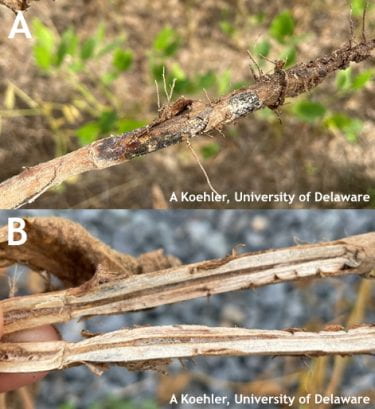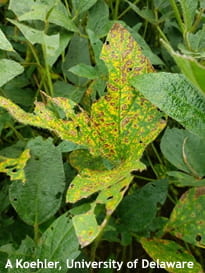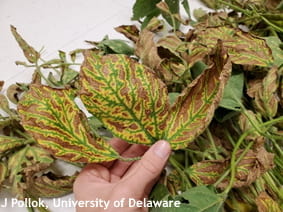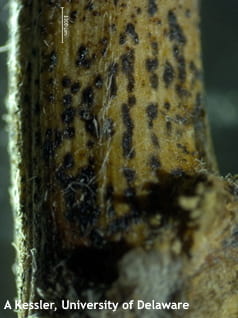Alyssa Koehler, Extension Field Crops Pathologist; akoehler@udel.edu
Just as we have seen more disease presence in corn over the past week, soybeans are also beginning to show symptoms of diseases that have accumulated through the season. One of the most frequent calls I have been receiving is soybean sudden death or SDS. Infection by the causal fungus Fusarium virguliforme usually occurs within the first 2 to 3 weeks after germination, but the level of symptom development varies greatly from year to year. Infection is favored by early planting into cool and wet soils and often is in combination with infection by soybean cyst nematodes (SCN). Symptoms of SDS do not usually develop until late in the season and are typically worse in years with heavy rainfall (or in irrigated fields). The weather patterns of the past few weeks with drought stress followed by abundant rain are tracking for the right environment to see disease.
Symptoms begin in the roots where the vascular tissue of the taproot becomes brown. While this can extend into the lower stem, these symptoms are not visible much above the soil line. The symptoms that really stick out are the patchy yellow lesions in the leaves that expand between the veins to brown lesions surrounded by chlorotic areas. While this can look very distinctive, it is important to remember that this leaf symptom can actually appear following infection by multiple organisms. Other diseases with similar symptoms include various stages of infection by the fungus Diaporthe (stem canker, pod and stem blight, seed decay), brown stem rot (BSR), charcoal rot, and others. While there are often exceptions to the rules or cases where multiple diseases can be present at the same time, the table below can be a starting point for separating some of our common soybean diseases (Table 1). The key is that leaves do not tell the whole story, so it is important to look closely at the base of the stem/roots and split stems to see what is happening within. One of the diagnostic signs for SDS are the blueish structures (sporodochia) at the base of the plant near the soil line. These can turn white once exposed to air, so it is best to look for them right as you are digging plants or if you have had plants incubating. Splitting stems is another way to sort out SDS, BSR, and charcoal rot. When splitting stems, SDS usually has brown outer vascular tissue (cortex), while BSR is brown in the center (pith) and the vascular tissue is usually still healthy looking. Charcoal rot will have numerous black dots called microsclerotia that are present on the outer stem and within the stem (Figure 1). Diseases from Diaporthe spp. will tend to have healthy looking vascular and pith tissue, but you may see black zone lines.

Figure 1. Microsclerotia of the fungus Macrophomina phaseolina causing charcoal rot in soybean. On the outside (A) and within a soybean stem (B)
Table 1: Sorting out soybean diseases with similar foliar symptoms
| Diaporthe species | Sudden Death Syndrome | Brown Stem Rot | |
| Leaves | Leaves typically stay attached. | Leaves fall off, can look like deer browsing. | Leaves typically stay attached. |
| Symptom |
Foliar symptoms from stem canker/pod and stem blight caused by Diaporthe species |
Foliar symptoms from SDS caused by Fusarium virguliforme |
Foliar and stem symptoms of brown stem rot. Photo credit: Crop Protection Network. |
| Sign |
Small black dots (pycnidia) may be in rows on stem tissue |
Blue sporodochia at the base of a soybean plant with SDS. Blue will often fade to white after exposure to air, so check soon after pulling up the plant. |
none |
| Taproot |
Split stem has limited discoloration and may have zone lines. |
Browning on either side of the interior. Roots will be discolored. |
Browning in the pith. BSR does not affect roots. |








